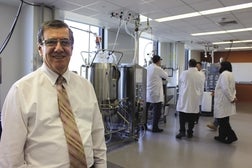Keep Mass. Life Science Center strong
After eight years of the Patrick Administration leading the state, it is inevitable that the new sheriff in town will want to make some changes. Sometimes those changes can be dramatic, and other times more subtle and harder to discern. That is why it was very interesting, and possibly revealing, when of a founding member of the Massachusetts Life Science Center resigned from his position citing a lack of communication and support from the Baker-Polito Administration for the state-sponsored $1-billion fund. Clearly, this is a program that has the fingerprints of the Patrick Administration all over it, and only time will tell whether Harvey Lodish, the MLSC scientific advisory board chairman, turns out to be a lone voice of dissent, or if he was venting the frustrations of his board and many others in the industry.
The MLSC was created back in 2008 with a $1-billion allocation and the expressed purpose of growing the bioscience industry over the coming 10 years. In resigning, Lodish complained the current administration is cutting funding critical to the organization's mission – especially for building new bioscience infrastructure. In addition, he expressed concern that current to MLSC president and CEO Travis McCready is not as well-versed in bioscience as his long-term predecessor in the position, Susan Windham Bannister.
In response to those criticisms, Governor Baker and McCready seem to be saying all the right things about the priority of keeping bioscience growth at the forefront of economic development in the state, but clearly there are significant differences behind the scenes that have spilled out into the public arena.
Of the $1 billion originally earmarked for the MLSC, roughly $400 million is left to spend. While state incentives for GE and any plan to reinvest in the commuter rail system disproportionately help Boston and the towns inside of Route 128, the MLSC fund has been used to help build infrastructure projects throughout the state, with a cool $90 million of those earmarked for the Sherman Center at UMass Medical School in Worcester. McCready, to his credit, seems highly aware of the opportunities in Central Massachusetts, given the region has the low-cost space and educated workforce that is especially attractive to growing startups and early-stage companies. You can read McCready's Viewpoint column in this issue (look left) calling for Central Mass. companies to apply for a tax incentive program MLSC is offering.
However, how the remaining funds will be distributed, or even if the remaining funding is to be spent, seems to be unresolved. Who can blame a new administration if they have different priorities or feel they have better ways to put those funds to use around the state? Bringing positive change was a large part of the reason Charlie Baker was elected, and why he maintains such high favorability ratings. So while we think the administration deserves some wiggle room to sort out what they feel is the highest best use of those funds, a wholesale reduction or change of the mission of the group seems unwarranted. Since so many state-sponsored programs and the focus of government spending starts in Boston and ripples out to the rest of the state, we need to remind leaders that a lot of that ripple does not make it out of the 128/495 belt. The MLSC has a record of supporting projects statewide, and we'd like to continue to see those incentives being delivered equitably to the state's many regions.













0 Comments